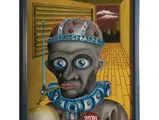Enamel on board, 1976. Signed and dated in lower right, framed. 18 x 14 inches. Painted in commemoration of the U.S. bicentennial in 1976. The piece represents a look at what life might be like in the year 2076. The image is a portrait of an almost emaciated, pale, grey-skinned figure. An elaborate metal collar with a radio antenna adorns his neck and is clasped together in front with an engraved lock bearing the initials �US� on the front. Atop the figure�s head is a metal helmet with wires that protrude into his scalp. At the crown of the helmet an elaborate sequence of numbers appear to run all the way around the figures head; this is thought by many to be a type of coding that suggests governmental control. The figure is situated in a long yellow hallway, which ends at a window revealing a dark outside world. The hairless body with enlarged eyes is void of expression, as the figure appears more like a robot than a human. The collar on the figure with the US inscribed lock alludes to the government�s constant watch and control over people. The coded numbers across the figure�s head acts like a type of coding system to classify people, such as a social security number. The presence of protruding wires and tubes also reference the robotic nature of the figure, they could perhaps allude to an adaptation of the modern computer, control and an intrinsic connection to man in the basest sense. Given that Von Dutch prided himself as the last �free man� the painting provides a visual commentary of his views regarding government and modern society. Dutch was an eccentric man and went to great lengths to assure his �freedom.� Dutch lived and worked out of a bus giving him a portable home and workshop, with no permanent address. Some say Dutch did not possess a driver�s license, and he claimed he did not even have a social security number. A truly revolutionary piece, it is amazing to think about how society has changed since 1976. At the time it was a prediction into the future. How close will society�s evolution be to what Dutch predicted in the years to come? Only time will tell, as 2076 rapidly approaches. It is interesting to note as well, pieces of art depicting the future illustrate a visionary approach as they incorporate the present into a conceptual reality beyond one�s general belief system. While most try to see the future in positive terms, Dutch could only see it as his mind would allow. The painting�s somewhat sad subject matter proves to illustrate his imagination�s preconceived notions of the future. Exhibition History: Laguna Art Museum, Laguna Beach (July 17 - November 7, 1993); Maryland Institute College of Art, Baltimore (December 3 - January 23, 1994); Center on Contemporary Art, Seattle (May 29 - July 17, 1994)
The Brucker Collection
Von Dutch - TriCentennial
{{lr.item.text}}
$32,200 USD | Sold
 | United States
| United States
{{internetCurrentBid}}
{{internetTimeLeft}}






